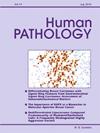Pure intertubular seminoma (PITS) of the testis: A multi-institutional cohort of a rare growth pattern of seminoma
IF 2.7
2区 医学
Q2 PATHOLOGY
引用次数: 0
Abstract
Pure intertubular seminoma (PITS) of the testis is described as the presence of seminoma cells within the interstitium of testis without any evidence of diffuse growth pattern or mass lesion of classical seminoma. These tumors are clinically and grossly inconspicuous and are diagnosed incidentally or during investigations for testicular pain, infertility or other symptoms. Rarely metastasis is the first presentation. Microscopic identification can be difficult and poses a diagnostic challenge in the absence of a mass lesion. Seminomas with exclusive intertubular growth patterns were gathered in an international cohort. Diagnoses were confirmed by fellowship-trained or specialized urologic pathologists. Cases with the presence of a classical diffuse or nested pattern of seminoma or any other germ cell tumor component were excluded. The patient's age, tumor characteristics and additional clinicopathologic features were recorded and analyzed. 15 patients of pure intertubular seminoma (PITS) were collated. The mean age of presentation was 29 years. Patients presented with variable symptoms, including undescended testis (26%, n = 4/15), testicular heaviness/pain (20%, n = 3/15) infertility (20%, n = 3/15) and metastasis (6%, n = 1/15); presentation was unknown in 4 patients. Of note, none of the patients presented because of testicular mass. Serum markers were within normal limits in most patients (93%, n = 14/15) with available data. No tumors were identified macroscopically; however, an ill-defined, grey-white, firm area was noted in one orchiectomy specimen. Microscopically, tumor cells were seen in intertubular spaces as dispersed individual cells or small clusters. Tumor cells were round to polygonal with large nuclei and prominent nucleoli. Mild to moderate lymphocytic infiltrates were seen admixed with tumor cells in 40% (n = 6/15) of the tumors. GCNIS was present in association with most PITS (73%, n = 11/15). Tubular atrophy with thickening of the basement membrane and Leydig cell hyperplasia was observed in one tumor. Thirty-three percent (n = 5/15) of the tumors showed pagetoid involvement of rete testis, including the tumor with metastasis. All tumors showed the classical immunohistochemical profile of seminoma, with PLAP, c-KIT, OCT3/4, D2-40 and SALL4 positivity. PITS can be clinically & pathologically inconspicuous, difficult to stage and liable to be misdiagnosed especially if presented with metastasis. Despite the inconspicuousness, PITS may represent an aggressive growth pattern of seminoma with the propensity for rete testis invasion.
睾丸纯输精管间精原细胞瘤(PITS):一种罕见精原细胞瘤生长模式的多机构队列。
睾丸纯管间精原细胞瘤(PITS)是指睾丸间质内存在精原细胞瘤细胞,但无任何弥漫生长模式或典型精原细胞瘤肿块病变的证据。这些肿瘤在临床上和大体上都不明显,是在偶然情况下或因睾丸疼痛、不育或其他症状进行检查时被诊断出来的。很少以转移为首发症状。显微镜下的鉴别可能比较困难,在没有肿块病变的情况下会给诊断带来挑战。我们在一个国际队列中收集了具有独特管间生长模式的精原细胞瘤。诊断由接受过研究员培训或专业的泌尿科病理学家确认。存在典型弥漫或巢状精原细胞瘤或任何其他生殖细胞肿瘤成分的病例均被排除在外。对患者的年龄、肿瘤特征和其他临床病理特征进行了记录和分析。共收集整理了15例纯管间精原细胞瘤(PITS)患者。患者的平均年龄为29岁。患者的症状不一,包括睾丸下降(26%,n=4/15)、睾丸沉重/疼痛(20%,n=3/15)、不育(20%,n=3/15)和转移(6%,n=1/15);4名患者的症状不明。值得注意的是,没有一名患者因睾丸肿块而就诊。大多数患者(93%,n=14/15)的血清标志物在正常范围内。宏观上未发现肿瘤,但在一份睾丸切除术标本中发现一个界限不清的灰白色坚实区域。显微镜下,肿瘤细胞以分散的单个细胞或小细胞簇的形式出现在管间隙中。肿瘤细胞呈圆形至多边形,核大,核仁突出。40%的肿瘤(n=6/15)中可见轻度至中度淋巴细胞浸润,与肿瘤细胞混杂在一起。大多数 PITS(73%,n=11/15)伴有 GCNIS。在一个肿瘤中观察到肾小管萎缩、基底膜增厚和莱狄格细胞增生。33%的肿瘤(n=5/15)显示睾丸前叶受累,其中包括有转移的肿瘤。所有肿瘤均显示精原细胞瘤的典型免疫组化特征,PLAP、c-KIT、OCT3/4、D2-40 和 SALL4 阳性。PITS 在临床和病理上都不明显,难以分期,容易误诊,尤其是在出现转移的情况下。尽管不明显,但PITS可能代表了精原细胞瘤的一种侵袭性生长模式,具有侵犯睾丸前叶的倾向。
本文章由计算机程序翻译,如有差异,请以英文原文为准。
求助全文
约1分钟内获得全文
求助全文
来源期刊

Human pathology
医学-病理学
CiteScore
5.30
自引率
6.10%
发文量
206
审稿时长
21 days
期刊介绍:
Human Pathology is designed to bring information of clinicopathologic significance to human disease to the laboratory and clinical physician. It presents information drawn from morphologic and clinical laboratory studies with direct relevance to the understanding of human diseases. Papers published concern morphologic and clinicopathologic observations, reviews of diseases, analyses of problems in pathology, significant collections of case material and advances in concepts or techniques of value in the analysis and diagnosis of disease. Theoretical and experimental pathology and molecular biology pertinent to human disease are included. This critical journal is well illustrated with exceptional reproductions of photomicrographs and microscopic anatomy.
 求助内容:
求助内容: 应助结果提醒方式:
应助结果提醒方式:


